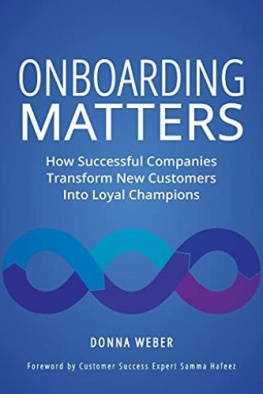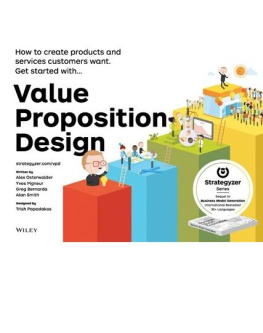Companies that disregard their customers shouldnt be surprised when they move on to other firms in the constant surge of customer churn. No one likes being ignored, especially buyers of sophisticated services, software or high-tech products with complex installation or use requirements. Frustrated customers will abandon these products, turning your software to shelfware. Although author Donna Weber tends to use jargon, she does a thorough job of explaining her process for training and retaining clients and for developing a supportive onboarding program that answers customers questions proactively to eliminate potential dissatisfaction.
Summary
Companies should cater to their customers.
Many firms pay little or no attention to their customers after they make a sale. Their onboarding programs, which intend to signal that they care about their customers, often prove ineffectual and more aggravating than helpful.
The beginning of the customer relationship is the most important part of the customer journey.
Negligent firms deposit new customers checks, then leave buyers to their own devices, forcing them to figure out how to derive the most or any benefit from their newly purchased products or services.
Customers who arent tech-savvy often cant figure out complex products.
Complex products and services such as software packages can intimidate customers, challenging them not only to figure out how to benefit from their purchases, but simply how to use them in the first place.
Whoever understands the customer best, wins. This means that when all products eventually become commoditized, the vendor-customer relationship will become the only relevant differentiator. (Mike Gospe, co-founder, KickStart Alliance)
Customers with new software packages may need to transfer information, connect interfaces, customize functions and learn new procedures. Thats a daunting menu, particularly for clients who arent tech-savvy.
Buyers who cant understand complicated products will abandon them and turn to another supplier.
If you do not provide quality onboarding, you may leave your customers confused and frustrated. Buyers are never inclined to do repeat business with companies that treat them poorly. Once customers realize a company wont help them, the effort to build positive, long-lasting relationships becomes an uphill, unrewarding struggle.
Orchestrated onboarding helps you quickly drive your customers to value, so they stick around.
In many cases, customers dont hesitate to switch to competitive products and services, happy to abandon firms that dont seem to care about them. A lack of quality onboarding for new customers can undermine a company, particularly an SaaS firm or other providers with recurring-revenue business models or subscription services.
While most companies pay for customer acquisition, they usually spend only a small amount on customer retention. This often includes firms that claim to be customer-centric.
Onboarding programs can eliminate customers frustration and confusion.
Quality onboarding is crucial during the early days after a purchase when the customer has just begun to experience and form an initial opinion of the product or service. Lack of first-rate onboarding at this moment creates a risk of customer churn.
Even if your solution can provide an order of magnitude return on investment, dont try to get there all at once. Provide quick wins for your customers by phasing your deployment. (customer-success leader Nello Franco)
What if a company offers a minor onboarding effort? Hastily conceived onboarding or support offered only in response to a query is almost as off-putting as no onboarding at all. Customers need an orchestrated onboarding program that involves all of your firms customer-facing departments and their employees.
Onboarding should present clients with a defined outreach program that is easy for them to access and understand. Onboarding a new customer requires your company to invest considerable time and effort, but it provides a substantial payoff in customer satisfaction, retention and positive recommendations.
With orchestrated onboarding, new customers will realize the full value of their association with your firm and its offerings. And your firm will benefit from developing that level of customer loyalty.
Orchestrated onboarding uses best practices from various business disciplines.
Onboarding is a complex activity that requires company-wide coordination. A harmonious, cohesive onboarding program draws on the best practices of your various departments, including customer service, sales, IT and financial services.
Orchestrating means planning and organizing with purposeful intent. Orchestrated onboarding is simple in theory: Guide your customers to success with your product. To be effective, onboarding must begin immediately upon purchase. This is when new customers have the greatest interest in improving their operations with your offering and the greatest willingness to invest time in learning every detail of their new acquisition.
When customers quickly identify the value you deliver, they stick around long enough to have a high lifetime value. (Shreesha Ramdas, Medallia Strikedeck)
Onboarding starts before a customer signs the purchase agreement and finalizes the deal. It continues during the crucial early days when customers develop their initial user perspective about your product or service. It may continue for additional days or even months. Regardless of how long onboarding takes, it should become your primary method for establishing trust and long-term relationships with customers.
The person in charge of your companys onboarding program must explain the group effort involved to all relevant departments to enlist their input and support in outlining and coordinating their roles.
The initial step of orchestrated onboarding is delivering first value to customers, helping them quickly discover your products value and utility. The sooner your customers hit this first-value point, the greater the advantages for your firm and theirs. Follow this approach to reduce the time it takes for customers to achieve first value:









